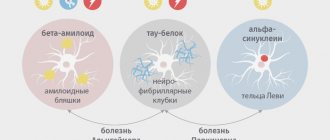Hippel-Lindau disease (Cerebroretinal angiomatosis)
The onset of neurological manifestations usually occurs in the 3rd-4th decades of life. In childhood, Hippel-Lindau disease is characterized by the appearance of neurological symptoms against the background of pre-existing visual disorders. In some cases, the disease in children manifests itself with subarachnoid hemorrhage.
CNS damage
. The most common source of primary symptoms is cerebellar cysts (cerebellar cysts). They manifest with general cerebral symptoms (diffuse headaches, nausea not associated with food intake, vomiting, tinnitus) caused by increased intracranial pressure. The first signs also include epileptic seizures; they can be generalized or focal. Over time, signs of cerebellar damage appear, forming the symptom complex of cerebellar ataxia: static and dynamic discoordination, adiadochokinesis, hypermetria and asynergia, intention tremor, myodystonia. As the cerebellar tumor grows, displacement and compression of the brain stem occurs, accompanied by brain stem symptoms, primarily swallowing disorder, diplopia, and dysarthria. Spinal tumors (usually angioreticulomas) are manifested by radicular syndromes, loss of deep types of sensitivity, and absence of tendon reflexes. In 80% of cases of spinal pathology, a clinical picture similar to syringomyelia is observed. A picture of complete damage to the diameter of the spinal cord is possible.
Eye damage
in the early stages they are diagnosed only by ophthalmoscopy. After 8 years, complaints about image hazyness and distortion (metamorphopsia) appear. In half of the patients, both eyes are affected. Retinal angiomas that increase over time lead to circulatory disorders in its vessels, ischemia and cystic degeneration. In the late stage, uveitis, cataracts, retinal detachment, glaucoma, and hemophthalmos are possible.
Kidney damage
in 60-90% of cases it is represented by cysts, in 45% of cases - renal cell carcinoma. As a rule, renal carcinoma clinically debuts between the ages of 40 and 50 years in patients who have previously been treated for neoplasms. In half of the cases, at the time of diagnosing carcinoma, its metastases are detected. The combination of polycystic kidney disease with retinal angiomatosis is more typical than its combination with cerebral angiomas. In 35% of patients with Hippel-Lindau disease, polycystic disease is diagnosed posthumously. In childhood, with a familial type of the disease, polycystic kidney disease is often its only manifestation.
Pheochromocytoma
in almost half of the cases it is bilateral. May be the only clinical manifestation of the disease. In combination with renal carcinoma it is quite rare.
Pancreatic damage
from 30 to 72% are cysts. Pancreatic cysts are benign and rarely lead to clinically significant pancreatic enzyme deficiency. Although there are known cases of complete replacement of normal gland tissue by a cyst with the development of diabetes mellitus.
Occurrence of the disease, gender and age of patients
Hippel-Lindau disease runs in families. The inheritance of this disease is autosomal dominant. This means that both sexes can be affected and no generation will be skipped. The mutation can be detected already at birth. But tumors appear only with age. The earliest recorded case of tumor appearance was 5 years. Most tumors appear between 15-35 years of age. However, there are no significant clinical differences between men and women.
Hippel-Lindau disease has an onset in every family. In every family there is a person who gets it for the first time.
It is often unclear who is the first carrier of such a gene, or who was the carrier. In such a person, the mutation occurs for the first time. Today, new mutations are frequently observed.
Treatment methods
While the tumor formations are small and not associated with any symptoms, they are not removed.
Excision of hemangioblastoma is carried out if the tumor has clear signs and is operable.
If the size of the formation is less than 3 cm, radiation therapy can be used. If the tumor is localized in the retina, laser coagulation or cryotherapy should be performed immediately.
When surgically treating the disease, it must be taken into account that tumors are usually multiple in nature. New formations may appear at any time, so it is impossible to completely cure the patient surgically.
Be careful, video of the operation! Click to open
Patients with this disease should be under constant medical supervision, which includes magnetic resonance imaging of the head and spinal cord.
Based on the results of this study, the doctor makes a decision regarding the need to remove specific tumors.
Medicines can be used as additional means.
In case of Hippel-Lindau disease, nootropics are often used - drugs to improve brain function. When the volume of glucose in the blood increases, the use of glucose-lowering drugs is indicated.
Pheochromocytoma
When the adrenal glands are damaged, Hippel-Lindau disease is manifested by the formation of pheochromocytoma. This neoplasm, originating from the substance of the adrenal medulla, is usually benign in nature. It is diagnosed in most cases at the age of about 30 years and is characterized by bilaterality, multiple nodes and the ability to transfer to tissues located nearby.
Pheochromocytoma manifests itself with the following symptoms:
- Arterial hypertension resistant to antihypertensive therapy.
- Blood pressure-related cranialgia.
- Pale skin.
- Tendency to hyperhidrosis.
- Tachycardia.
The development process is rapid and irreversible
There are several stages of development of this disease:
- Preclinical . It is characterized by initial accumulations of capillaries and their slight expansion.
- Classic . At this stage, typical retinal angiomas are formed.
- Exudative . It is characterized by high permeability of the walls of angiomatous nodes.
- At the fourth stage , retinal detachment occurs, and it can be tractional or exudative in nature.
- Terminal . At this stage, glaucoma, uveitis, and phthisis of the eyeball develop.
If you start treating Hippele Lindau disease at an early stage, you can achieve fairly effective results. In addition, thanks to timely therapy, it is possible to minimize the risk of complications.
Hippel-Lindau disease is characterized by intention tremor. What other diseases accompany this symptom?
Brain astrocytoma is a serious tumor that can be fatal. What methods of removing formations exist?
Mechanism of disease development
Hippel Lindau syndrome is transmitted in an autosomal dominant manner. This means that if one parent has the defective gene, the child has a 50% risk of developing the disease.
This syndrome appears in people of different ages and has different manifestations even in close relatives.
Approximately 90% of people with this disease develop at least one symptom by age 65.
Until methods for early diagnosis were developed, patients usually did not live past the age of fifty.
In recent years, the prognosis of the disease has improved markedly, since there are methods for early detection of pathology and new technologies for its treatment.
Treatment
General approaches to the treatment of Hippel-Lindau syndrome correspond to the principles of cancer therapy. Therapy should be comprehensive and combine surgical and radiation methods. Each of them is used strictly in accordance with the indications, contraindications, characteristics of the specific tumor and the patient’s condition.
Medications are used mainly as symptomatic therapy to correct certain functions of individual organs and the general condition of the patient.
Retinal angiomatosis
For ophthalmological localization of the pathological process, a characteristic feature is a triad of signs:
- presence of angioma;
- vasodilation in the fundus;
- the presence of subretinal exudation (accumulation of fluid - a product of inflammation - under the cornea), which can cause the development of exudative retinal detachment at an advanced stage of the disease.
The initial stages of the disease are characterized by decreased pigmentation in the fundus and increased tortuosity of blood vessels. When pressing on the eyeball, pulsation of both arteries and veins is noted.
At later stages, vasodilation and vascular tortuosity progress, and the formation of aneurysms and angiomas, which have the characteristic appearance of rounded glomeruli, is possible - this is a specific sign of Hippel-Lindau disease.
Hemangioblastoma of the central nervous system
The most commonly reported manifestation of von Hippel-Lindau syndrome is the development of hemangioblastoma of the cerebellum, spinal cord, or retina. A tumor developed on the cerebellum has the following manifestations:
- Headaches of a bursting nature.
- Nausea, vomiting.
- Uncertainty when walking due to poor coordination.
- Dizziness.
- Impaired consciousness (typical of later stages of pathology).
When hemangioblastoma is localized in the spinal cord, the main clinical symptoms are decreased sensitivity, paresis and paralysis, disturbances in the processes of urination and defecation. Pain syndrome is observed only occasionally.
This type of tumor is classified as slowly progressing. And the most informative examination method for diagnosis and control is considered to be magnetic resonance imaging (MRI), enhanced by contrasting the area under study.
The only effective treatment for cerebellar hemangioblastoma today is its surgical removal. The use of radiation and drug methods did not show convincing positive results.
After microsurgical removal, hemangioblastoma, as a rule, does not recur, but other neoplasms may appear. When surgically treating this tumor, it is necessary to take into account its multiplicity, which is typical for Hippel-Lindau disease.
Types of disease
Traditionally, the types of Hippel-Lindau disease differ depending on the occurrence of pheochromocytoma. This medical term refers to a tumor with good blood circulation, surrounded by a specific capsule. Previously, only the presence or absence of a tumor was considered a criterion. This issue has now been reviewed. The dominant occurrence of pheochromocytoma is also taken into account.
- Type 1 Hippel-Lindau disease: families with significant absence of pheochromocytoma;
- Type 2: families with a dominant presence of pheochromocytoma;
- Type 2A: families as type 2, but without renal carcinomas;
- Type 2B: families as type 2, but with frequent renal carcinoma;
- Type 2C: families with a dominant presence of pheochromacytoma, but without manifestation of the disease in other organs.










